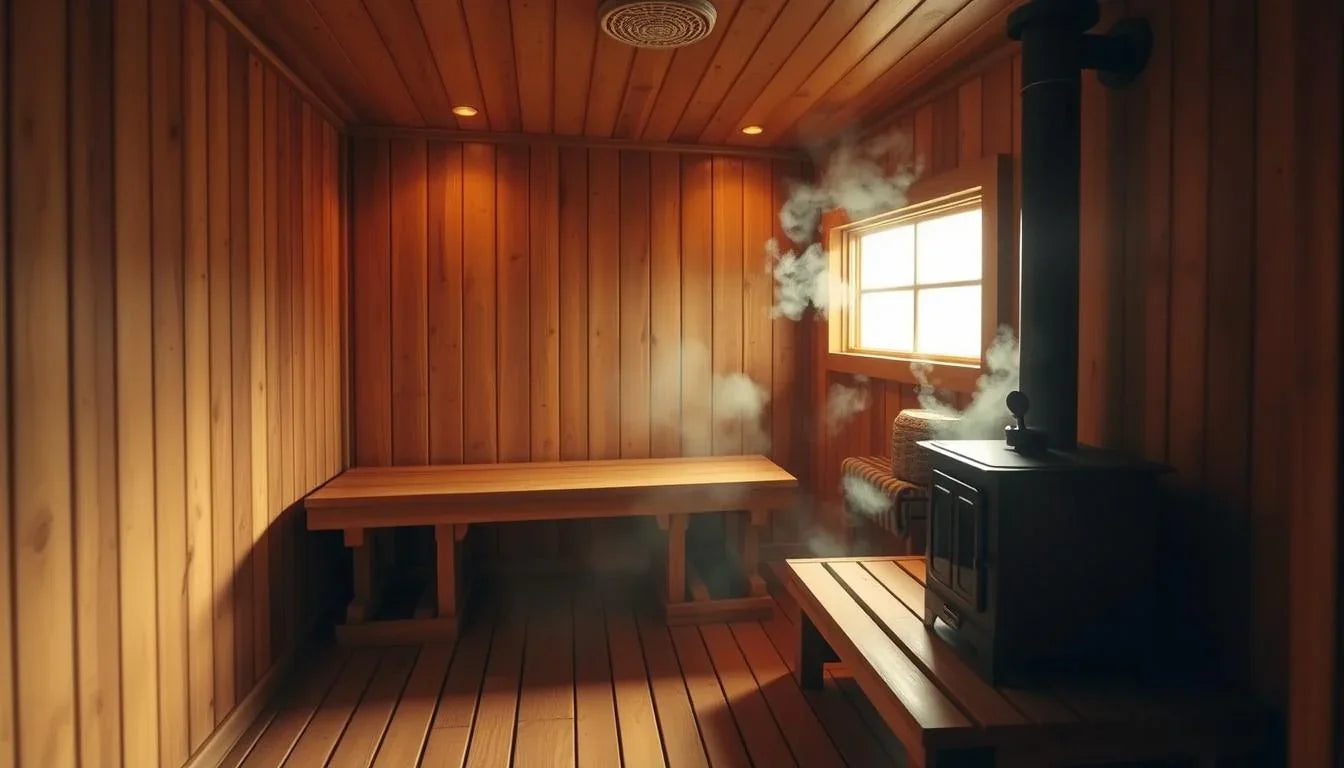
Infrared Sauna Workout: A Guide to Sweating Wellness
Infrared Sauna Workout: A Guide to Sweating Wellness
This guide introduces a practical method to layer gentle heat over structured movement so the body reaches training readiness faster and supports broad wellness goals.
Combining radiant warmth with short, focused sessions primes muscles and joints, speeds circulation, and can reduce soreness. Many studios pair 30-minute isometrics or brief HIIT with controlled heat to accelerate calorie burn and conditioning.
Readers will discover the basics, step-by-step routines, and clear safety practices so the approach serves as an evidence-informed, results-oriented way to train. Expect practical tips on pacing, hydration with electrolytes, and cool-down to protect performance and recovery.
Whether the goal is faster warm-ups, better recovery, or a way to take training to the next level, this guide bridges science and application. It offers adaptable plans for different fitness levels so you can feel best in your next session.
Key Takeaways
- Layering heat with movement helps prime the body and muscles for exercise.
- Short, timed sessions can speed circulation and aid recovery.
- Hydration and pacing are essential for safe, effective results.
- The guide offers step-by-step routines and safety practices.
- Approach is adaptable for fitness levels and focused on long-term wellness.
Discover Infrared Heat: How It Works and Why It Elevates Your Workout
Radiant wavelengths warm tissues directly, so the body reaches a working temperature faster without relying on super-hot air. Far-infrared energy heats skin and nearby surfaces, producing a gentle, sun-like warmth that many find more tolerable.
This temperature profile raises core temperature and can boost metabolism. The steady rise in temperature helps shorten long warm-ups and sets the stage for efficient exercise. Many users report increased comfort while still feeling meaningful training stimulus.
Physiological effects include increased blood flow and improved circulation. Better delivery of oxygen and nutrients helps muscles recover and reduces soreness. The gentle warmth can also help loosen tight tissues, improving flexibility before movement.
https://www.youtube.com/watch?v=gfMcU5QDk2I
| Mechanism | Immediate Effect | Practical Benefit |
|---|---|---|
| Radiant heat energy | Direct surface warming | Feel heat faster; shorter warm-up |
| Elevated temperature | Higher heart rate, metabolism | Boosts calorie burn during exercise |
| Improved circulation | Increase blood flow to muscles | Faster recovery; less soreness |
| Relaxing environment | Mood uplift, serotonin effects | Better focus and relaxation |
Prepare for Success: Set Up Your Infrared Sauna Session the Right Way
Start with a quick readiness check so the session supports fitness goals without creating risk. Confirm recent meals, current energy, and any medications. If you have heart disease, lung issues, high blood pressure, or are pregnant, get medical clearance first.
Choose the right heat experience
Direct radiant systems warm the body and may also help loosen deep muscle tissue for recovery. Traditional or steam rooms raise ambient temperature and humidity, which can boost circulation and metabolic demand. Pick the match based on tolerance and goals.

Dress for sweat and flexibility
Wear breathable, moisture-wicking layers that allow movement. Simple tops, shorts, or yoga attire support range of motion and help loosen tight areas.
Hydration and electrolytes
Arrive well-hydrated, sip fluids during the session, and replace electrolytes afterward—coconut water or a balanced sports drink works. Severe fluid loss can cause dizziness, low blood pressure, or worse, so plan intake.
- Bring a towel, non-slip mat, and a marked water bottle to track intake.
- Start conservatively if new to heated exercise and exit if you feel faint.
How to Do an Infrared Sauna Workout: Step-by-Step Routine for Results
A planned routine inside the heated cabin turns short sessions into efficient training blocks that raise core temperature and sharpen movement readiness. Follow a clear order: warm-up, working rounds, and a gentle in-unit cool-down before you step out.

Pre-workout warm-up in the cabin
Spend 10–15 minutes on deep breathing and gentle stretches. This raises core temperature, helps tissues loosen, and starts to increase blood flow so muscles respond better.
Intermittent training and time-based intervals
Alternate short heat periods with equal rest to build tolerance and cardio fitness. A simple pattern is 5 minutes inside, 5 minutes rest or light movement. Repeat 2–4 cycles depending on fitness level.
HOTWORX-style 3D training and hot yoga flow
For higher intensity, combine heat and focused isometrics or short HIIT at around 125°F for quick readiness and higher calorie burn. For mobility and recovery days, use a 90–100°F hot yoga flow to improve flexibility and reduce stiffness.
Sauna-friendly exercises and session structure
Select confined-space movements: push-ups, squats, planks, bicycle crunches, and low-impact cardio bursts. Keep sets short and precise to maintain form during elevated temperature.
"Program sessions as warm-up, 2–3 working rounds, then a calm in-unit transition to cool down."
- Control breathing cadence to manage perceived exertion as heat help elevates effort.
- Carry a towel and water; expect to sweat a lot and plan hydration within reach.
- Adjust total minutes and intensity to match your level for safe, consistent results.
Train Smart: Pacing, Safety, and Recovery in Heated Sessions
When heat and movement are combined, careful monitoring keeps sessions productive and safe. Start with short, 10–15 minute sessions and progress slowly so the body adapts without excess strain.

Monitor intensity and heart rate
Track heart rate and perceived exertion. Use intervals to prevent spikes in core temperature during an intense workout. Alternate harder efforts with brief rests to let circulation stabilize and reduce injury risk.
If you feel dizzy, nauseous, or notice a rapid pulse, step out and hydrate. Returning only when steady protects long-term progress.
Cool down and restore
After the session, cool down with slow walking, breathing drills, and light stretches. Gentle movement supports flexibility and relaxation while avoiding additional nervous-system stress.
Heat exposure dilates vessels to increase blood delivery and helps flush metabolic waste. This process also helps reduce inflammation and supports muscle recovery through heat‑shock protein pathways.
| Focus | Action | Benefit |
|---|---|---|
| Pacing | Short sets, interval rest | Controlled temperature rise; less risk |
| Safety cues | Monitor HR, watch for dizziness | Prevents fainting and injury |
| Recovery | Stretching, foam rolling | Reduced soreness; better circulation |
| Adaptation | Progress weekly, not daily | Improved endurance and muscle repair |
Conclusion
Combining gentle heat and concise exercise rounds streamlines preparation and aids the body's repair processes. When used thoughtfully, traditional and radiant approaches complement training by expediting warm-up, supporting circulation, and promoting recovery.
Choose a clear method that matches goals and experience: intermittent rounds, a HOTWORX-style protocol, or a mobility-focused flow. Each option gives structured ways to apply heat safely and productively while fitting busy schedules.
Prioritize consistency over intensity. Small, repeatable sessions help muscles and the cardiovascular system adapt without setbacks. Track progress and increase load gradually.
Finally, put safety first: hydrate, watch heart rate, and scale session length as you learn how your body responds. Keep wellness as the guiding goal for every decision.
FAQ
What is far‑infrared heat and how does it warm the body differently from hot air?
Far‑infrared energy penetrates the skin and raises core tissue temperature directly, rather than simply heating the surrounding air. That targeted warming increases circulation and can help muscles feel more pliable during movement, making sessions feel like a deeper, more efficient heat exposure compared with traditional steam or dry heat.
What are the main health benefits people report from heated sessions paired with exercise?
Users commonly report improved blood flow, faster muscle recovery, temporary increases in metabolic rate, reduced muscle tightness, and improved mood after heated sessions. These effects support recovery and flexibility when combined with low‑impact exercise or mobility work.
Should I see a healthcare professional before trying heated training?
Yes. People with cardiovascular conditions, uncontrolled high blood pressure, pregnancy, or certain chronic illnesses should consult their clinician first. A professional can assess risk, recommend session length and temperature limits, and advise on hydration or medication interactions.
How do I choose between far‑infrared panels and a traditional hot room for fitness goals?
Far‑infrared systems deliver direct tissue heating at lower ambient temperatures and are ideal for focused recovery and mobility work. Traditional steam or dry heat provides high ambient temperature and humidity, which some users prefer for intense sweating. Match the method to goals—deep tissue heating and comfort vs. high ambient heat and maximal sweating.
What should I wear during a heated exercise session to stay safe and comfortable?
Opt for breathable, moisture‑wicking layers that allow freedom of movement. Lightweight, stretchy fabrics help loosen muscles while preventing chafing. Avoid heavy or non‑breathable clothing that traps excessive heat and sweat.
How important are hydration and electrolytes for a heated session?
Very important. Heated sessions increase sweat and fluid loss, so drink water before, during, and after. For longer or intense sessions, include electrolyte replacement to prevent dizziness, cramping, and dehydration‑related risks.
What is a safe step‑by‑step routine to pair heat exposure with exercise?
Start with a short warm‑up inside the heated space to raise core temperature and increase circulation. Follow with time‑limited intervals of low‑impact strength or mobility work, alternating with rest outside the heat. Finish with a cool‑down, rehydration, and gentle stretching to support recovery.
How do intermittent time‑based intervals work during heated training?
Intermittent intervals alternate brief activity bouts with recovery periods to manage cardiovascular load and core temperature. For example, 10–15 minutes in heat doing mobility or isometrics, then 5–10 minutes rest. Adjust intervals based on fitness, heat tolerance, and heart rate responses.
Can heated rooms be combined with HIIT or isometric formats like HOTWORX‑style sessions?
Yes, many programs combine targeted heat with HIIT or isometric holds to intensify perceived exertion and metabolic stimulus. However, these formats increase cardiovascular stress—monitor heart rate closely, shorten intervals if needed, and prioritize hydration and recovery.
What types of exercises are best suited for a heated environment?
Bodyweight strength, core stabilization, mobility flows, low‑impact cardio, and hot yoga sequences work well. These activities benefit from increased flexibility and blood flow while limiting impact and excessive cardiovascular strain.
How should intensity and heart rate be monitored to avoid overheating or injury?
Use a heart rate monitor and stay within recommended zones for your fitness level. Watch for warning signs—lightheadedness, nausea, rapid heartbeat—and stop if they occur. Shorten sessions and lower intensity if recovery feels impaired.
What are the best cool‑down and recovery practices after a heated session?
Cool down gradually with gentle stretching and controlled breathing. Rehydrate with water and electrolytes, and consider anti‑inflammatory strategies like rest, compression, or targeted cold therapy for sore areas. Adequate sleep and protein intake also support muscle repair.







Leave a comment
This site is protected by hCaptcha and the hCaptcha Privacy Policy and Terms of Service apply.